For other uses, see Ginger (disambiguation).
"Gingers" redirects here. For the Australian punk rock group, see The Gingers.
| Ginger | |
|---|---|
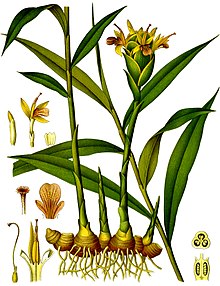 |
|
| Color plate from Köhler's Medicinal Plants | |
| Scientific classification |
|
| Kingdom: | Plantae |
| clade: | Angiosperms |
| clade: | Monocots |
| clade: | Commelinids |
| Order: | Zingiberales |
| Family: | Zingiberaceae |
| Genus: | Zingiber |
| Species: | Z. officinale |
| Binomial name | |
| Zingiber officinale Roscoe 1807[1] |
|
Etymology
The English name ginger comes from French: gingembre, Old English: gingifere, Medieval Latin: ginginer, Greek: zingíberis (ζιγγίβερις). Ultimately the origin is from Tamil:'inji ver'. The botanical term for root in Tamil is ver (வேர்), hence inji root or inji ver.Horticulture
Ginger produces clusters of white and pink flower buds that bloom into yellow flowers. Because of its aesthetic appeal and the adaptation of the plant to warm climates, ginger is often used as landscaping around subtropical homes. It is a perennial reed-like plant with annual leafy stems, about a meter (3 to 4 feet) tall. Traditionally, the rhizome is gathered when the stalk withers; it is immediately scalded, or washed and scraped, to kill it and prevent sprouting. The fragrant perisperm of Zingiberaceae is used as sweetmeats by Bantu, also as a condiment and sialogogue.Uses
Ginger produces a hot, fragrant kitchen spice.Oung ginger rhizomes are juicy and fleshy with a very mild taste. They are often pickled in vinegar or sherry as a snack or just cooked as an ingredient in many dishes. They can also be steeped in boiling water to make ginger tea, to which honey is often added; sliced orange or lemon fruit may also be added. Ginger can also be made into candy. Mature ginger rhizomes are fibrous and nearly dry. The juice from old ginger roots is extremely potent and is often used as a spice in Indian recipes, and is a quintessential ingredient of Chinese, Korean, Japanese and many South Asian cuisines for flavoring dishes such as seafood or goat meat and vegetarian cuisine. Ginger acts as a useful food preservative.Fresh ginger can be substituted for ground ginger at a ratio of 6 to 1, although the flavors of fresh and dried ginger are somewhat different. Powdered dry ginger root is typically used as a flavoring for recipes such as gingerbread, cookies, crackers and cakes, ginger ale, and ginger beer.
Candied ginger is the root cooked in sugar until soft, and is a type of confectionery.
Fresh ginger may be peeled before eating. For longer-term storage, the ginger can be placed in a plastic bag and refrigerated or frozen.
Regional use
In Western cuisine, ginger is traditionally used mainly in sweet foods such as ginger ale, gingerbread, ginger snaps, parkin, ginger biscuits and speculaas. A ginger-flavored liqueur called Canton is produced in Jarnac, France. Green ginger wine is a ginger-flavored wine produced in the United Kingdom, traditionally sold in a green glass bottle. Ginger is also used as a spice added to hot coffee and tea.In India and Pakistan, ginger is called adrak in Hindi, Punjabi and Urdu, aad in Maithili, aadi in Bhojpuri, aada in Bengali, Adu in Gujarati, hashi shunti (ಹಸಿ ಶುಂಟಿ) in the Kannada, allam (అల్లం) in Telugu, inji (இஞ்சி) in Tamil and Malayalam, inguru (ඉඟුරු) in Sinhalese, alay in Marathi, and aduwa(अदुवा ) in Nepali. Fresh ginger is one of the main spices used for making pulse and lentil curries and other vegetable preparations. Fresh, as well as dried, ginger is used to spice tea and coffee, especially in winter. Ginger powder is also used in certain food preparations, particularly for pregnant or nursing women, the most popular one being katlu which is a mixture of gum resin, ghee, nuts, and sugar. Ginger is also consumed in candied and pickled form. In Bangladesh, ginger is finely chopped or ground into a paste to use as a base for chicken and meat dishes alongside shallot and garlic.
In Burma, ginger is called gyin. It is widely used in cooking and as a main ingredient in traditional medicines. It is also consumed as a salad dish called gyin-thot, which consists of shredded ginger preserved in oil, and a variety of nuts and seeds. In Indonesia, a beverage called wedang jahe is made from ginger and palm sugar. Indonesians also use ground ginger root, called jahe, as a common ingredient in local recipes. In Malaysia, ginger is called halia and used in many kinds of dishes, especially a soup. In the Philippines it is brewed into a tea called salabat. In Vietnam, the fresh leaves, finely chopped, can also be added to shrimp-and-yam soup (canh khoai mỡ) as a top garnish and spice to add a much subtler flavor of ginger than the chopped root.
In China, sliced or whole ginger root is often paired with savory dishes such as fish, and chopped ginger root is commonly paired with meat, when it is cooked. However, candied ginger is sometimes a component of Chinese candy boxes, and a herbal tea can also be prepared from ginger.
In Japan, ginger is pickled to make beni shoga and gari or grated and used raw on tofu or noodles. It is also made into a candy called shoga no sato zuke. In the traditional Korean kimchi, ginger is finely minced and added to the ingredients of the spicy paste just before the fermenting process.
In the Caribbean, ginger is a popular spice for cooking, and making drinks such as sorrel, a seasonal drink made during the Christmas season. Jamaicans make ginger beer both as a carbonated beverage and also fresh in their homes. Ginger tea is often made from fresh ginger, as well as the famous regional specialty Jamaican ginger cake.
On the island of Corfu, Greece, a traditional drink called τσιτσιμπύρα (tsitsibira), a type of ginger beer, is made. The people of Corfu and the rest of the Ionian islands adopted the drink from the British, during the period of the United States of the Ionian Islands.
In Arabic, ginger is called zanjabil, and in some parts of the Middle East, ginger powder is used as a spice for coffee and for milk, as well. In Somaliland, ginger is called sinjibil, and is served in coffee shops in Egypt. In the Ivory Coast, ginger is ground and mixed with orange, pineapple and lemon to produce a juice called nyamanku. Ginger powder is used in hawaij, a spice mixture used mostly by Yemenite Jews for soups and coffee.
Ginger tea
Ginger tea is a beverage in many countries, made from ginger root. In China, the tea is made by boiling peeled and sliced ginger to which brown sugar is often added. Sliced orange or lemon fruit may also be added to give a flavor. In Korean cuisine, ginger tea is called saenggang cha (생강차). It can be made either by boiling the ginger or by mixing hot water and preserved sweetened ginger. For the latter, sliced ginger root is stored with honey for a few weeks like jam. In Japanese cuisine it is called shōgayu (生姜湯). In Philippine cuisine it is called salabat and served in the relatively cold month of December. From its main ingredient ginger tea derives a flavor that is spicy and stimulating.Preliminary research
Preliminary research indicates that nine compounds found in ginger may bind to human serotonin receptors which may influence gastrointestinal function.Research conducted in vitro tests show that ginger extract might control the quantity of free radicals and the peroxidation of lipids. Preliminary studies involving the effect of ginger on nausea occurring with pregnancy suggest that intake of ginger may cause belching after ingestion In a 2010 study, daily consumption of ginger was shown to help ease muscle pain associated with exercise by 25%. Ginger root supplement has been identified in one study to help reduce colon inflammation markers such as PGE2, thus indicating a measure that might affect colon cancer. In limited studies, ginger was found to be more effective than placebo for treating nausea caused by seasickness, morning sickness and chemotherapy,[17][18][19][20] although ginger was not found superior to placebo for pre-emptively treating post-operative nausea. Other preliminary studies showed that ginger may affect arthritis pain or have blood thinning and cholesterol lowering properties, but these effects remain unconfirmed. Advanced glycation end-products are possibly associated in the development of diabetic cataract for which ginger was effective in preliminary studies, apparently by acting through antiglycating mechanisms. Zingerone may have activity against enterotoxigenic Escherichia coli in enterotoxin-induced diarrhea.Folk medicine

A packet of ginger powder from the Philippines used in brewing salabat (ginger tea).
Tea brewed from ginger is a common folk remedy for colds. Ginger ale and ginger beer are also drunk as stomach settlers in countries where the beverages are made.
- In Burma, ginger and a local sweetener made from palm tree juice (htan nyat) are boiled together and taken to prevent the flu.
- In China, ginger is included in several traditional preparations. A drink made with sliced ginger cooked in water with brown sugar or a cola is used as a folk medicine for the common cold.[35] "Ginger eggs" (scrambled eggs with finely diced ginger root) is a common home remedy for coughing.[citation needed] The Chinese also make a kind of dried ginger candy that is fermented in plum juice and sugared, which is also commonly consumed to suppress coughing. Ginger has also been historically used to treat inflammation, which several scientific studies support, though one arthritis trial showed ginger to be no better than a placebo or ibuprofen for treatment of osteoarthritis.[21]
- In Congo, ginger is crushed and mixed with mango tree sap to make tangawisi juice, which is considered a panacea.
- In India, ginger is applied as a paste to the temples to relieve headache, and consumed when suffering from the common cold. Ginger with lemon and black salt is also used for nausea.
- In Indonesia, ginger (jahe in Indonesian) is used as a herbal preparation to reduce fatigue, reducing "winds" in the blood, prevent and cure rheumatism and control poor dietary habits.[citation needed]
- In Nepal, ginger is called aduwa, अदुवा and is widely grown and used throughout the country as a spice for vegetables, used medically to treat cold and also sometimes used to flavor tea.
- In the Philippines, ginger is known as luya and is used as a throat lozenge in traditional medicine to relieve sore throat. It is also brewed into a tea known as salabat.[36][37]
- In the United States, ginger is used to prevent motion and morning sickness. It is recognized as safe by the Food and Drug Administration and is sold as an unregulated dietary supplement. Ginger water was also used to avoid heat cramps in the United States.
- In Peru, ginger is sliced in hot water as an infusion for stomach aches as infusión de Kión.
- In Japan it is purported to aid blood circulation.[38] Scientific studies investigating these effects have been inconclusive.[34]
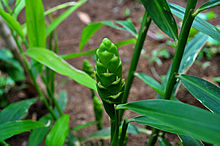

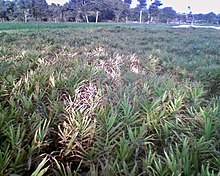
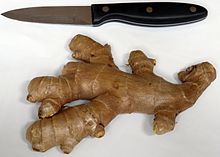
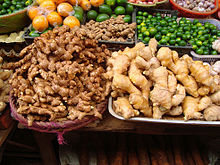
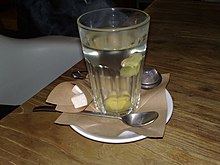

Tidak ada komentar:
Posting Komentar